认知机器人Cognitive Robot
机器人智能感知与认知技术研究

机器人智能感知与认知技术研究随着人工智能的快速发展,机器人在日常生活中扮演着越来越重要的角色。
机器人的智能感知与认知技术作为其中重要的一环,成为了科学家们关注的热点。
本文将对机器人的智能感知与认知技术进行研究与探讨。
一、智能感知技术智能感知技术是机器人实现感知能力的基础。
通过不同的传感器,机器人可以感知到周围的外界环境和目标物体。
比如,视觉感知技术能够让机器人通过摄像头获取图像,并进行图像识别、目标检测等操作。
声音感知技术则可以让机器人听到声音,并进行语音识别、情感分析等操作。
此外,还有触觉感知技术、力矩感知技术等,使机器人能够感知到物体的质地、形状、压力等信息。
在智能感知技术的基础上,机器人可以进行环境理解和情境感知。
通过对环境的感知,机器人可以获取到地图、位置、路面状况等信息,从而做出相应决策。
情境感知则是指机器人对于特定情境的理解和反应,比如对话中的上下文理解、语境分析等。
这些技术的发展将极大地提升机器人的自主性和适应性。
二、智能认知技术智能认知技术是机器人进行高级认知和智能决策的重要手段。
通过模拟人类的认知过程,机器人能够更好地理解和分析信息。
机器人的智能认知技术主要包括自然语言处理、知识表示与推理、机器学习等。
自然语言处理技术使得机器人能够理解和产生符合语法和语义规则的自然语言。
通过对自然语言的解析和理解,机器人可以进行对话、问答等交流方式。
这在人机交互方面具有重要意义,使得机器人能够更好地与人类进行沟通和合作。
知识表示与推理技术是指通过构建知识图谱和推理模型,使得机器人能够储存和处理大量的知识。
机器人可以从知识图谱中获取到相关的知识,并进行推理、判断、决策等操作。
这样的技术将有助于机器人更加智能地应对复杂的任务和场景。
机器学习技术是指通过训练算法和模型,使得机器人能够从大量的数据中学习和提取规律。
机器人可以通过机器学习算法进行数据分析和模式识别,从而不断改进和优化自己的行为和决策。
这样的技术使得机器人能够自主地学习和适应环境,具备更高的智能水平。
关于智能机器人的认识

关于智能机器人路径规划的认识樊阳阳仪器仪表工程学号2013704008摘要智能机器人是人工智能的理想研究平台,是一个在感知、思维、效应方面全面模拟人的机器系统,它是人工智能技术的综合试验场,可以全面地考察人工智能各个领域的技术。
在简要介绍智能机器人及发展状况的基础上,深入阐述了机器人在其路径规划算法的研究现状,对全局的路径规化算法作出了详细的研究,指出各种算法的优缺点,提出建立嵌入式智能机器人路径规划平台,实现了基于嵌入式实时系统的智能机器人路径规划算法。
关键词:嵌入式技术;路径规划;智能机器人On the Understanding of the Intelligent Robot PathPlanningAbstractIntelligent robot is an ideal research platform, artificial intelligence (ai) is a comprehensive simulation in terms of perception, thinking, effect of machine system, it is a comprehensive range of artificial intelligence technology, can fully inspect all areas of artificial intelligence technology. The brief introduction of intelligent robots and the development status, on the basis of deeply expounds the robot in its research status quo of path planning algorithm for global path planning algorithm made a detailed research, and points out the advantages and disadvantages of various algorithms, the proposed embedded intelligent robot path planning platform, realizes the intelligent robot path planning algorithm based on embedded real-time system. Key words:Embedded technology;Path planning;Intelligent robot目录前言 (4)第1章智能机器人的未来发展 (5)第2章智能机器人的路径规划技术研究 (7)第3章全局路径规划算法研究 (8)第3.1节构型空间法 (8)第3.2节可视图法 (8)第3.3节优化算法 (8)第3.4节拓扑法 (8)第3.5节栅格解耦法 (9)第3.6节自由空间法 (9)第3.7节神经网络法 (9)第4章嵌入式智能机器人路径规划算法的应用与实现 (11)结论 (12)参考文献 (13)前言智能机器人是一个在感知、思维、效应方面全面模拟人的机器系统,外形不一定像人。
机器人学导论

History
The idea of robot goes back to ancient time in the world.
Leonardo da Vinci created many human-inspired, robot-like sketches, designs, and models in the 1500’s.
木牛流马
History
The idea of robot goes back to ancient time in the world.
The 2nd century B.C., the ancient Greece person in Alexander time‘s has invented the most primitive robot “ automaton”. By the power of the water, the air and the steam pressure, the statue(雕像) can move and even open the door as well as sing.
Leonardo Humanoid Robot with Internal Mechanisms
History
Jaquet-Droz Automata (雅克-德罗机械人偶),1774
The Writer「作家」,The Draughtsman「画家」和The Musician「音乐家」
History
The Western Zhou Dynasty, our country‘s skilled craftsman Yan (偃师)developed the actor who could sing and dance well, this was the robot which our country recorded most early.
高考英语专题练之说明文阅读

2022高考英语专题练之说明文阅读(A)If you want to stay in shape, but don’t have the time to go to the gym, the Mobile Gym is a good solution. It’s basically a large bus filled with the latest fitness equipment. You can find everything you need for a complete workout, and here’s the best part — you don’t need to go to the gym, and the gym comes to you!The Mobile Gym was the idea of Adam Zickerman, founder of Inform Fitness, a popular chain of gyms across the United States. It hit him when he ordered lunch from a food truck one afternoon. So why not put a gym on a truck?Zickerman experimented with a few designs and then invested $60,000 on making adaptations and fixing machines. He didn’t really need an advertising budget as the bus advertised itself. Carole Pallmeyer, for instance, found herself driving behind the Mobile Gym one day. At first she thought it was a regular bus with ads for a gym. But then she realized the bus itself was a gym, so she booked workout sessions for her entire family. “We are all busy, but we know the bus is coming and make sure we are home at 4:30 for the workouts,” she said. “You forget you’re on a bus because the workouts are tightly scheduled.”Unfortunately, it is illegal to use the fitness equipment while the bus is moving, so you don’t get to save time by working out during the rush time. It operates only once a week, only two clients ( 客户) can be accommodated at a time on the bus. And it doesn’t come cheap. Sessions start at $100, while in-house workouts are $65. But the Mobile Gym appears to be a big hit.“There are so many benefits to having the Mobile Gym come to you,” Zickerman said. “Only five to seven exercises complete a total-body workout when performed using our special equipment.” He also added that a 20-minute workout might sound easy, but it is really difficult and provides instant results. “It is very challenging and clients understand quickly why rest is important between workouts.”1.What inspired Zickerman to invent the Mobile Gym?A.A usual order for a meal.B.A casual visit to a gym.C.A tight schedule for workout.D.A specific experience of exercise. 2.Which of the following is NOT the benefit of the Mobile Gym?A.It saves much of clients’ time.B.It creates adequate private space.C.It offers special equipment needed for a total-body workout.D.It provides clients with an appropriate and effective workout.3.What’s Zickerman’s attitude towards the Mobile Gym?A.Concerned.B.Negative.C.Objective.D.Optimistic.(B)“We are running out of space and the only places to go to are other worlds... Spreading out may be the only thing that saves us from ourselves. I am convinced that humans need to leave Earth.” These are the words of the famous scientist Stephen Hawking, spoken at a science festival in Norway in 2017, a year before his death.Hawking was not alone in this view. Many experts feel that the only way for humanity to last far into the future is to colonize other planets. That way, if an asteroid(小小小), a terrible disease, nuclear war, or some other disaster strikes Earth, civilization as we know it would still have a chance. Mars is one of the most tempting destinations. NASA, the United Arab Emirates, the private company SpaceX, and the organization Mars One all have plans to send humans there. “Either we spread Earth to other planets, or we risk going extinct, SpaceX founder Elon Musk said at a conference in 2013.But not everyone agrees that colonizing Mars or any other planet is such a great plan. The most common argument against going is that it’s just too expensive or dangerous. It will take huge amounts of money and other resources just to get people there, let alone set up a place for them to live. It’s not even clear if humans could survive on Mars. One of the biggest dangers there is deadly radiation that bombards the planet.Maybe all the time and money people would pour into a Mars mission would be better spent on more urgent projects here on Earth, like dealing with poverty or climate change. Some experts argue that handling a problem like an asteroid strike or disease outbreak while staying here on Earth would be much easier and less expensive than surviving on a new planet.In addition, moving to a new planet could harm or destroy anything that already lives there. Mars seems uninhabited, but it could possibly host microbial( 小小小小) life. Human visitors maydestroy this life or permanently change or damage the Martian environment. Some feel that’s too much of a risk to take.What do you think? Should humans colonize outer space or stay home?1.What can be inferred from the passage?A.Many experts insist that humans should take the risk.B.Mars is the most attractive destinations for human beings.C.Hawking firmly believes the only way to save humans is moving to Mars.D.All the other experts don’t agree with Hawking’s idea.2.Why do some experts disagree with the plan to colonize Mars?A.It will cost much more money to settle on Mars than on Earth.B.It is too long a distance from the Earth to the Mars.C.Human visitors will bring diseases to Martian environment.D.The deadly radiation that bombards the planet is the biggest danger.3.What’s the writing purpose of the passage?A.To raise people’s awareness of protecting the environment.B.To present different opinions on whether to move to the Mars.C.To arouse readers’ reflection on whether to colonize outer space.D.To inspire people to deal with the environmental problems.4.In which section of a magazine is the passage most likely from?A. Fiction.B. Current affairs.C. Social Studies.D. Science.(C)We use what is known as inner speech, where we talk to ourselves, to evaluate situations and make decisions. Now, a robot has been trained to speak aloud its inner decision-making process, giving us a view of how it responds to contradictory demands.Arianna Pipitone and Antonio Chella at the University of Palermo, Italy, programmed a humanoid robot named Pepper, with software that models human cognitive(认知的)processes, which allowed Pepper to retrieve (检索)relevant information from its memory and find the correct way to act based on human commands, as well as a text — to — speech processor. It allowed Pepper to voice its decision-making process while completing a task, "With inner speech,we can better understand what the robot wants to do and what its plan is," says Chella.The researchers asked Pepper to set a dinner table according to etiquette (礼仪)rules they had programmed into the robot. Inner speech was either enabled or disabled to see how it affected Pepper's ability to do what was instructed.When instructed to place a napkin on a fork with its inner speech enabled, Pepper asked itself what the etiquette required and concluded that this request went against the rules it had been given. It then asked the researchers if putting the napkin on the fork was the correct action. When told it was, Pepper said, “OK, I prefer to follow your desire," and explained how it was going to place the napkin on the fork.When asked to do the same task with inner speech disabled, Pepper knew this contradicted etiquette rules, so it didn't perform the task or explain why.With the potential for robots to become more common in the future, this type of programming could help the public understand their abilities and limitations, says Sarah Sebo at the University of Chicago. "It maintains people's trust and enables cooperation and interactions between humans and robots," she says. However, this experiment only used a single human participant, says Sebo. "It's unclear how their approach would compare across a wide range of human participants," she says.1. Why does the author mention how people make decisions in the first paragraph?A. To introduce the topic.B. To make comparisons.C. To provide an example.D. To support his argument.2. How did Pepper react to the contradictory instruction with its inner speech enabled?A. It failed to complete the task.B. It followed the etiquette rules.C. It made a random decision.D. It communicated with the researchers.3. What did Sarah Sebo think of the research?A. It was creative but worthless.B. It was a good try but the result was a failure.C. It was inspiring but needed further evidence.D. It was carefully designed but poorly performed.4. Which of the following is the best title for the text?A. Robot Taught To Be PoliteB. Robot Can Explain Its DecisionC. Robot Making Decisions: No Longer A DreamD. Robot-Human Communication: No Longer A Problem(D)Researchers have found that most shy children,even the most painfully shy of them,are not shy adults.The process from shy to outgoing does not require treatment,behavior modification(矫正)or any extraordinary measures. It just happens.Most shy kids grow out of their shyness by their young adult years,and even those who do not get rid of it manage to cope with it reasonably well. They learn how to hide it,mostly because they realize that shyness puts them at a disadvantage in certain situations.I myself am a living example to the transformation.I was socially awkward until I went to college where I tried out for the role of a lead singer in a rock band and suddenly found myself on stage with four musicians behind me and hundreds of people in front of me. My social awkwardness didn't go away until I was forced to make a choice between shyness or being a campus rock star. That's a no-brainer for an 18-year-old. I had to cure myself of my lifelong shyness, and I did.But this article is not really about childhood shyness. It's about the distinction between a child's personality and behavior. Personality is just like a surface upon which an artist begins a painting. If the artist doesn't like the way his painting is progressing, he can paint over what he's done, but the surface remains as it was at the beginning-a constant (恒量)。
机器人自主感知与认知研究

机器人自主感知与认知研究随着科技的发展,机器人已经渐渐地走入人们的生活中。
机器人一直是科学家们研究的热点之一。
近年来,机器人已经开始自主感知和认知,不再仅仅是按照人类的指令进行操作,而是通过自身的感知和认知能力,进行自主决策和行动。
本文将围绕机器人自主感知与认知展开探讨,分为以下四个部分:定义与分类、感知能力、认知能力和未来展望。
一、定义与分类机器人自主感知可以定义为机器人自主获取外部环境信息的能力,包括机器人自主感知周围环境的物体、声音、光照等,以及对这些信息的处理和分析。
而机器人自主认知则是机器人根据对外部环境的感知信息进行自主决策和行动的能力。
机器人自主感知与认知不仅可以提高机器人的智能水平,也可以使机器人更加灵活地应对不同场景,同时还可以提高机器人与人类的交互性,改善人机交互体验。
根据机器人的不同功能和应用场景,可以将机器人分为不同的类别。
一般而言,机器人主要分为工业机器人、军事机器人、医疗机器人、服务机器人、家庭机器人等。
不同种类的机器人的自主感知和认知能力也有所不同。
二、感知能力机器人的自主感知能力是实现机器人自主认知的基础。
机器人的感知能力主要包括视觉感知、听觉感知、触觉感知、GPS定位等。
具体地说,机器人的视觉感知能力可以通过摄像头等装置来实现。
机器人可以通过图像识别技术和计算机视觉技术,对周围的物体、颜色、形状等信息进行感知和分析。
这一技术已经在很多领域得到了广泛的应用,如智能家居、智能安防、智能导航等。
机器人的听觉感知能力可以通过麦克风等装置来实现。
机器人通过声音探测和语音识别技术,可以对环境中的声音和语音进行感知和分析。
这一技术已经在智能助手和智能音箱等领域得到了广泛应用。
机器人的触觉感知能力可以通过接触传感器等装置来实现。
机器人可以通过接触传感器感知周围环境的物体的硬度、粗糙度等信息,从而实现对物体的识别和判断。
这一技术已经在医疗机器人、工业机器人等领域得到了广泛应用。
机器人的GPS定位是实现机器人自主移动的关键技术。
对工业机器人的了解和认识
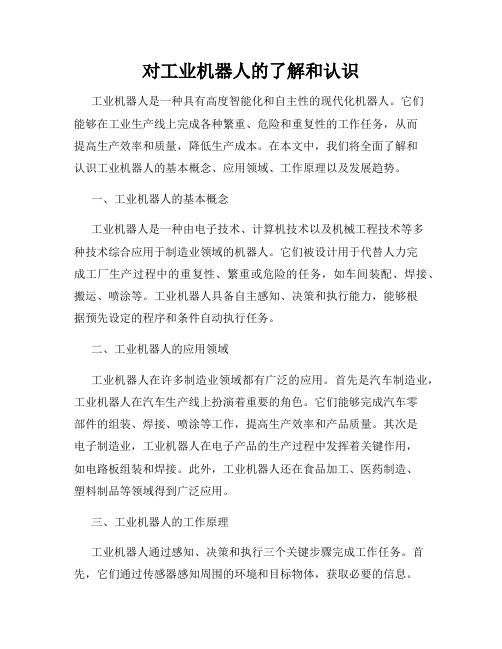
对工业机器人的了解和认识工业机器人是一种具有高度智能化和自主性的现代化机器人。
它们能够在工业生产线上完成各种繁重、危险和重复性的工作任务,从而提高生产效率和质量,降低生产成本。
在本文中,我们将全面了解和认识工业机器人的基本概念、应用领域、工作原理以及发展趋势。
一、工业机器人的基本概念工业机器人是一种由电子技术、计算机技术以及机械工程技术等多种技术综合应用于制造业领域的机器人。
它们被设计用于代替人力完成工厂生产过程中的重复性、繁重或危险的任务,如车间装配、焊接、搬运、喷涂等。
工业机器人具备自主感知、决策和执行能力,能够根据预先设定的程序和条件自动执行任务。
二、工业机器人的应用领域工业机器人在许多制造业领域都有广泛的应用。
首先是汽车制造业,工业机器人在汽车生产线上扮演着重要的角色。
它们能够完成汽车零部件的组装、焊接、喷涂等工作,提高生产效率和产品质量。
其次是电子制造业,工业机器人在电子产品的生产过程中发挥着关键作用,如电路板组装和焊接。
此外,工业机器人还在食品加工、医药制造、塑料制品等领域得到广泛应用。
三、工业机器人的工作原理工业机器人通过感知、决策和执行三个关键步骤完成工作任务。
首先,它们通过传感器感知周围的环境和目标物体,获取必要的信息。
然后,机器人根据预先编写的程序和算法进行决策,确定如何执行任务。
最后,机器人根据决策结果,通过运动控制系统驱动执行器,完成任务。
四、工业机器人的发展趋势随着科学技术的进步和工业生产的要求,工业机器人正不断发展和演进。
首先,人机协作成为了一个重要的发展趋势,机器人能够与人类工作人员在同一工作区域内共同完成任务。
其次,机器人的智能化程度不断提高,能够通过学习和适应不同的工作环境和任务要求。
此外,机器人的柔性化和模块化设计也是未来发展的重点,能够满足不同生产情况下的需求。
综上所述,工业机器人是一种能够自主执行工作任务的现代化机器人。
它们在各个制造业领域都有广泛的应用,能够提高生产效率和产品质量。
谈谈你对机器人的认识【精选文档】

认识机器人机器人的发展史:认识机器人首先先了解下robot机器人这一词是怎么来的。
1920年捷克作家卡雷尔·卡佩克发表了科幻剧本《罗萨姆的万能机器人》.在剧本中,卡佩克把捷克语“Robota”写成了“Robot”,“Robota"是奴隶的意思.该剧预告了机器人的发展对人类社会的悲剧性影响,引起了大家的广泛关注,被当成了机器人一词的起源。
从此,“robot"以及相对应的中文“机器人”一词开始在全世界流行。
上个世纪60年代前后,随着微电子学和计算机技术的迅速发展,自动化技术也取得了飞跃性的变化,开始出现了现在普遍意义上的机器人.1959年,美国英格伯格和德沃尔制造出世界上第一台工业机器人,取名“尤尼梅逊”,意为“万能自动”.尤尼梅逊的样子像一个坦克炮塔,炮塔上伸出一条大机械臂,大机械臂上又接着一条小机械臂,小机械臂再安装着一个操作器。
这三部分都可以相对转动、伸缩,很像是人的手臂了.它的发明人专门研究了运动机构与控制信号的关系,编制出程序让机器记住并模仿、重复进行某种动作。
英格伯格和德沃尔认为汽车制造过程比较固定,适合用这样的机器人。
于是,这台世界上第一个真正意义上的机器人,就应用在了汽车制造生产中。
经过近百年来的发展,机器人已经在很多领域中取得了巨大的应用成绩,其种类也不胜枚举,几乎各个高精尖端的技术领域更是少不了它们的身影。
在这期间,机器人的成长经历了三个阶段.第一个阶段中,机器人只能根据事先编好的程序来工作,这时它好像只有干活儿的手,不懂得如何处理外界的信息。
打个比方,如果让这样的机器人去抓会损坏它的东西,它也一定会去做。
第二个阶段中,机器人好像有了感觉神经,具有了触觉、视觉、听觉、力觉等功能,这使得它可以根据外界的不同信息做出相应的反馈。
如果再让它去抓某些东西,它可能就不干啦。
第三个阶段,机器就真正长大成人啦,这时它不仅具有多种技能,能够感知外面的世界,而且它还能够不断自我学习,用自己的思维来决策该做什么和怎样去做。
人工智能机器人的认知能力提升
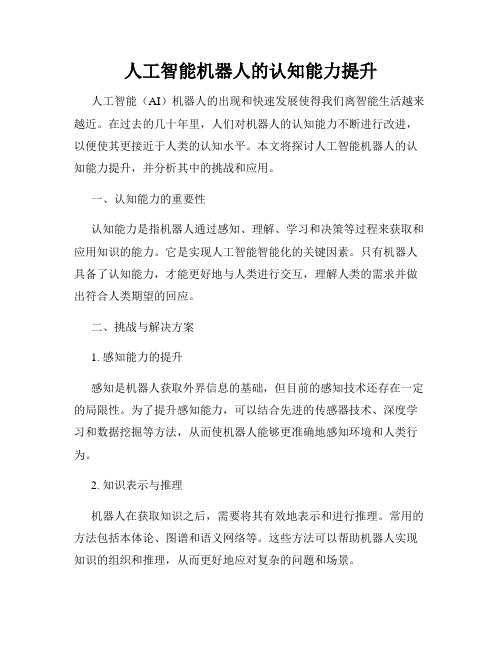
人工智能机器人的认知能力提升人工智能(AI)机器人的出现和快速发展使得我们离智能生活越来越近。
在过去的几十年里,人们对机器人的认知能力不断进行改进,以便使其更接近于人类的认知水平。
本文将探讨人工智能机器人的认知能力提升,并分析其中的挑战和应用。
一、认知能力的重要性认知能力是指机器人通过感知、理解、学习和决策等过程来获取和应用知识的能力。
它是实现人工智能智能化的关键因素。
只有机器人具备了认知能力,才能更好地与人类进行交互,理解人类的需求并做出符合人类期望的回应。
二、挑战与解决方案1. 感知能力的提升感知是机器人获取外界信息的基础,但目前的感知技术还存在一定的局限性。
为了提升感知能力,可以结合先进的传感器技术、深度学习和数据挖掘等方法,从而使机器人能够更准确地感知环境和人类行为。
2. 知识表示与推理机器人在获取知识之后,需要将其有效地表示和进行推理。
常用的方法包括本体论、图谱和语义网络等。
这些方法可以帮助机器人实现知识的组织和推理,从而更好地应对复杂的问题和场景。
3. 学习能力的提高机器人的学习能力是指其通过数据和经验不断改进和优化自身的能力。
为了提高学习能力,可以采用增强学习、迁移学习和自适应学习等方法。
通过这些方法,机器人可以从不断的实践中积累经验,并逐步完善自己的认知模型。
三、应用案例与前景展望1. 个人助理机器人个人助理机器人是指能够理解和执行个人需求的机器人。
通过不断的学习和认知能力提升,个人助理机器人可以更好地理解人类的语言和情感,并为人们提供个性化的服务和建议。
2. 智能驾驶车辆智能驾驶车辆是利用人工智能技术实现自动驾驶的汽车。
通过提升机器人的认知能力,例如更好地感知和理解交通情况,智能驾驶车辆可以提高交通安全性和驾驶效率。
3. 医疗机器人医疗机器人可以协助医生进行手术、提供远程诊断和治疗等服务。
通过提升认知能力,机器人可以更准确地理解医学知识和患者需求,从而提供更高效和精确的医疗服务。
人工智能的外在形象——机器人
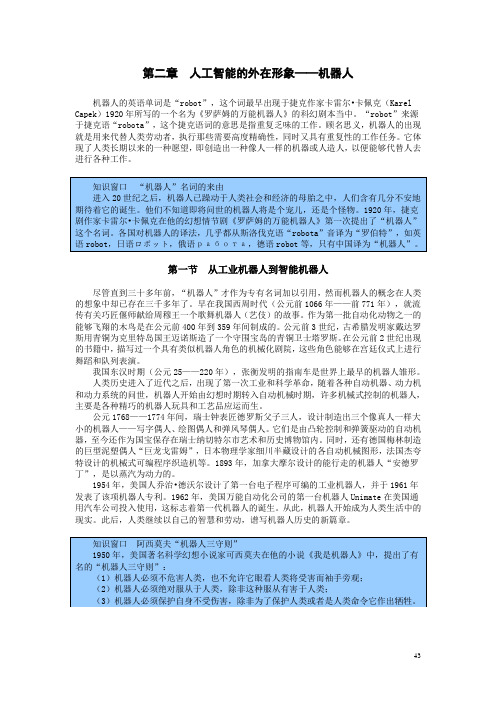
第二章人工智能的外在形象——机器人机器人的英语单词是“robot”,这个词最早出现于捷克作家卡雷尔•卡佩克(Karel Capek)1920年所写的一个名为《罗萨姆的万能机器人》的科幻剧本当中。
“robot”来源于捷克语“robota”,这个捷克语词的意思是指重复乏味的工作。
顾名思义,机器人的出现就是用来代替人类劳动者,执行那些需要高度精确性,同时又具有重复性的工作任务。
它体现了人类长期以来的一种愿望,即创造出一种像人一样的机器或人造人,以便能够代替人去进行各种工作。
第一节从工业机器人到智能机器人尽管直到三十多年前,“机器人”才作为专有名词加以引用,然而机器人的概念在人类的想象中却已存在三千多年了。
早在我国西周时代(公元前1066年——前771年),就流传有关巧匠偃师献给周穆王一个歌舞机器人(艺伎)的故事。
作为第一批自动化动物之一的能够飞翔的木鸟是在公元前400年到359年间制成的。
公元前3世纪,古希腊发明家戴达罗斯用青铜为克里特岛国王迈诺斯造了一个守围宝岛的青铜卫士塔罗斯。
在公元前2世纪出现的书籍中,描写过一个具有类似机器人角色的机械化剧院,这些角色能够在宫廷仪式上进行舞蹈和队列表演。
我国东汉时期(公元25——220年),张衡发明的指南车是世界上最早的机器人雏形。
人类历史进入了近代之后,出现了第一次工业和科学革命,随着各种自动机器、动力机和动力系统的问世,机器人开始由幻想时期转入自动机械时期,许多机械式控制的机器人,主要是各种精巧的机器人玩具和工艺品应运而生。
公元1768——1774年间,瑞士钟表匠德罗斯父子三人,设计制造出三个像真人一样大小的机器人——写字偶人、绘图偶人和弹风琴偶人。
它们是由凸轮控制和弹簧驱动的自动机器,至今还作为国宝保存在瑞士纳切特尔市艺术和历史博物馆内。
同时,还有德国梅林制造的巨型泥塑偶人“巨龙戈雷姆”,日本物理学家细川半藏设计的各自动机械图形,法国杰夸特设计的机械式可编程序织造机等。
机器人(Robotics)与人工智能( Artificial Intelligence)到底是个啥呢?

机器人(Robotics)与人工智能(Artificial Intelligence)到底是个啥呢?大数据的浪潮开始没多久,机器人和人工智能专业就以迅雷不及掩耳之势占据了留学的热门专业大榜,工程类专业的留学意向者中有一半左右都说“老师,我想申请美国的机器人专业或者人工智能”,那么问题来了:请问你知道美国的机器人/人工智能是什么专业呢?他们有什么区别?有哪些学校设置这类专业的学位课程?今天,小编将带你揭开机器人和人工智能的神秘面纱。
什么是人工智能(Artificial Intelligence)?人工智能这个术语最初是由约翰.麦卡锡(John McCarthy)编写的一种名为LISPAI编程语言信息来源:/technology/difference-between-robots-and-artificial-intellige nce/生硬的文字或许很难理解这两个根本上的差异,在此小编以美国西北大学为例详细讲解,希McCormick School of Engineering & Applied Science 麦考克工程与应用科学学院Electrical Engineering and Computer Science电子工程和计算机科学下设3个大部:ElectricalEngineeringDivisionComputerEngineeringDivisionComputerScienceDivisionComputer Engineeringdivision:Computer architectureComputer-aided designMobile systemsParallel processingHardware softwareinteractionVLSI designEmbedded systemsSystems simulationRoboticsLarge-scale systems翻译:计算机工程方向:计算机架构计算机辅助设计移动系统并行处理硬件软件交互VLSI设计嵌入式系统系统仿真机器人大型系统http://www.mccormick.northwester/eecs/computer-engineering/graduate/Computer Science division:Systems and NetworkingTheoryArtificial Intelligence andMachine LearningHuman-Computer InteractionGraphicsRoboticsCS+X翻译:计算机科学方向:系统和网络理论人工智能和机器学习人机交互图像学机器人计算机科学+ 其他学科http://www.mccormick.northwester/eecs/computer-science/graduate/美国西北大学的麦考克工程与应用科学学院是美国的顶尖工程学院之一,2019年USNEWS排第20位,学院致力于用创新的教育计划激发学生的全脑性思维,促进教育和研究。
自动化专业英语词汇大全

自动化专业英语词汇大全acceleration transducer 加速度传感器acceptance testing 验收测试accessibility 可及性accumulated error 累积误差AC-DC-AC frequency converter 交-直-交变频器AC (alternating current) electric drive 交流电子传动active attitude stabilization 主动姿态稳定actuator 驱动器,执行机构adaline 线性适应元adaptation layer 适应层adaptive telemeter system 适应遥测系统adjoint operator 伴随算子admissible error 容许误差aggregation matrix 集结矩阵AHP (analytic hierarchy process) 层次分析法amplifying element 放大环节analog-digital conversion 模数转换annunciator 信号器antenna pointing control 天线指向控制anti-integral windup 抗积分饱卷aperiodic decomposition 非周期分解a posteriori estimate 后验估计approximate reasoning 近似推理a priori estimate 先验估计articulated robot 关节型机器人assignment problem 配置问题,分配问题associative memory model 联想记忆模型associatron 联想机asymptotic stability 渐进稳定性attained pose drift 实际位姿漂移attitude acquisition 姿态捕获AOCS (attritude and orbit control system) 姿态轨道控制系统attitude angular velocity 姿态角速度attitude disturbance 姿态扰动attitude maneuver 姿态机动attractor 吸引子augment ability 可扩充性augmented system 增广系统automatic manual station 自动-手动操作器automaton 自动机autonomous system 自治系统backlash characteristics 间隙特性base coordinate system 基座坐标系Bayes classifier 贝叶斯分类器bearing alignment 方位对准bellows pressure gauge 波纹管压力表benefit-cost analysis 收益成本分析bilinear system 双线性系统biocybernetics 生物控制论biological feedback system 生物反馈系统black box testing approach 黑箱测试法blind search 盲目搜索block diagonalization 块对角化Boltzman machine 玻耳兹曼机bottom-up development 自下而上开发boundary value analysis 边界值分析brainstorming method 头脑风暴法breadth-first search 广度优先搜索butterfly valve 蝶阀CAE (computer aided engineering) 计算机辅助工程CAM (computer aided manufacturing) 计算机辅助制造Camflex valve 偏心旋转阀canonical state variable 规范化状态变量capacitive displacement transducer 电容式位移传感器capsule pressure gauge 膜盒压力表CARD 计算机辅助研究开发Cartesian robot 直角坐标型机器人cascade compensation 串联补偿catastrophe theory 突变论centrality 集中性chained aggregation 链式集结chaos 混沌characteristic locus 特征轨迹chemical propulsion 化学推进calrity 清晰性classical information pattern 经典信息模式classifier 分类器clinical control system 临床控制系统closed loop pole 闭环极点closed loop transfer function 闭环传递函数cluster analysis 聚类分析coarse-fine control 粗-精控制cobweb model 蛛网模型coefficient matrix 系数矩阵cognitive science 认知科学cognitron 认知机coherent system 单调关联系统combination decision 组合决策combinatorial explosion 组合爆炸combined pressure and vacuum gauge 压力真空表command pose 指令位姿companion matrix 相伴矩阵compartmental model 房室模型compatibility 相容性,兼容性compensating network 补偿网络compensation 补偿,矫正compliance 柔顺,顺应composite control 组合控制computable general equilibrium model 可计算一般均衡模型conditionally instability 条件不稳定性configuration 组态connectionism 连接机制connectivity 连接性conservative system 守恒系统consistency 一致性constraint condition 约束条件consumption function 消费函数context-free grammar 上下文无关语法continuous discrete event hybrid system simulation 连续离散事件混合系统仿真continuous duty 连续工作制control accuracy 控制精度control cabinet 控制柜controllability index 可控指数controllable canonical form 可控规范型[control] plant 控制对象,被控对象controlling instrument 控制仪表control moment gyro 控制力矩陀螺control panel 控制屏,控制盘control synchro 控制[式]自整角机control system synthesis 控制系统综合control time horizon 控制时程cooperative game 合作对策coordinability condition 可协调条件coordination strategy 协调策略coordinator 协调器corner frequency 转折频率costate variable 共态变量cost-effectiveness analysis 费用效益分析coupling of orbit and attitude 轨道和姿态耦合critical damping 临界阻尼critical stability 临界稳定性cross-over frequency 穿越频率,交越频率current source inverter 电流[源]型逆变器cut-off frequency 截止频率cybernetics 控制论cyclic remote control 循环遥控cylindrical robot 圆柱坐标型机器人damped oscillation 阻尼振荡damper 阻尼器damping ratio 阻尼比data acquisition 数据采集data encryption 数据加密data preprocessing 数据预处理data processor 数据处理器DC generator-motor set drive 直流发电机-电动机组传动D controller 微分控制器decentrality 分散性decentralized stochastic control 分散随机控制decision space 决策空间decision support system 决策支持系统decomposition-aggregation approach 分解集结法decoupling parameter 解耦参数deductive-inductive hybrid modeling method 演绎与归纳混合建模法delayed telemetry 延时遥测derivation tree 导出树derivative feedback 微分反馈describing function 描述函数desired value 希望值despinner 消旋体destination 目的站detector 检出器deterministic automaton 确定性自动机deviation 偏差deviation alarm 偏差报警器DFD 数据流图diagnostic model 诊断模型diagonally dominant matrix 对角主导矩阵diaphragm pressure gauge 膜片压力表difference equation model 差分方程模型differential dynamical system 微分动力学系统differential game 微分对策differential pressure level meter 差压液位计differential pressure transmitter 差压变送器differential transformer displacement transducer 差动变压器式位移传感器differentiation element 微分环节digital filer 数字滤波器digital signal processing 数字信号处理digitization 数字化digitizer 数字化仪dimension transducer 尺度传感器direct coordination 直接协调disaggregation 解裂discoordination 失协调discrete event dynamic system 离散事件动态系统discrete system simulation language 离散系统仿真语言discriminant function 判别函数displacement vibration amplitude transducer 位移振幅传感器dissipative structure 耗散结构distributed parameter control system 分布参数控制系统distrubance 扰动disturbance compensation 扰动补偿diversity 多样性divisibility 可分性domain knowledge 领域知识dominant pole 主导极点dose-response model 剂量反应模型dual modulation telemetering system 双重调制遥测系统dual principle 对偶原理dual spin stabilization 双自旋稳定duty ratio 负载比dynamic braking 能耗制动dynamic characteristics 动态特性dynamic deviation 动态偏差dynamic error coefficient 动态误差系数dynamic exactness 动它吻合性dynamic input-output model 动态投入产出模型econometric model 计量经济模型economic cybernetics 经济控制论economic effectiveness 经济效益economic evaluation 经济评价economic index 经济指数economic indicator 经济指标eddy current thickness meter 电涡流厚度计effectiveness 有效性effectiveness theory 效益理论elasticity of demand 需求弹性electric actuator 电动执行机构electric conductance levelmeter 电导液位计electric drive control gear 电动传动控制设备electric hydraulic converter 电-液转换器electric pneumatic converter 电-气转换器electrohydraulic servo vale 电液伺服阀electromagnetic flow transducer 电磁流量传感器electronic batching scale 电子配料秤electronic belt conveyor scale 电子皮带秤electronic hopper scale 电子料斗秤elevation 仰角emergency stop 异常停止empirical distribution 经验分布endogenous variable 内生变量equilibrium growth 均衡增长equilibrium point 平衡点equivalence partitioning 等价类划分ergonomics 工效学error 误差error-correction parsing 纠错剖析estimate 估计量estimation theory 估计理论evaluation technique 评价技术event chain 事件链evolutionary system 进化系统exogenous variable 外生变量expected characteristics 希望特性external disturbance 外扰fact base 事实failure diagnosis 故障诊断fast mode 快变模态feasibility study 可行性研究feasible coordination 可行协调feasible region 可行域feature detection 特征检测feature extraction 特征抽取feedback compensation 反馈补偿feedforward path 前馈通路field bus 现场总线finite automaton 有限自动机FIP (factory information protocol) 工厂信息协议first order predicate logic 一阶谓词逻辑fixed sequence manipulator 固定顺序机械手fixed set point control 定值控制FMS (flexible manufacturing system) 柔性制造系统flow sensor/transducer 流量传感器flow transmitter 流量变送器fluctuation 涨落forced oscillation 强迫振荡formal language theory 形式语言理论formal neuron 形式神经元forward path 正向通路forward reasoning 正向推理fractal 分形体,分维体frequency converter 变频器frequency domain model reduction method 频域模型降阶法frequency response 频域响应full order observer 全阶观测器functional decomposition 功能分解FES (functional electrical stimulation) 功能电刺激functional simularity 功能相似fuzzy logic 模糊逻辑game tree 对策树gate valve 闸阀general equilibrium theory 一般均衡理论generalized least squares estimation 广义最小二乘估计generation function 生成函数geomagnetic torque 地磁力矩geometric similarity 几何相似gimbaled wheel 框架轮global asymptotic stability 全局渐进稳定性global optimum 全局最优globe valve 球形阀goal coordination method 目标协调法grammatical inference 文法推断graphic search 图搜索gravity gradient torque 重力梯度力矩group technology 成组技术guidance system 制导系统gyro drift rate 陀螺漂移率gyrostat 陀螺体Hall displacement transducer 霍尔式位移传感器hardware-in-the-loop simulation 半实物仿真harmonious deviation 和谐偏差harmonious strategy 和谐策略heuristic inference 启发式推理hidden oscillation 隐蔽振荡hierarchical chart 层次结构图hierarchical planning 递阶规划hierarchical control 递阶控制homeostasis 内稳态homomorphic model 同态系统horizontal decomposition 横向分解hormonal control 内分泌控制hydraulic step motor 液压步进马达hypercycle theory 超循环理论I controller 积分控制器identifiability 可辨识性IDSS (intelligent decision support system) 智能决策支持系统image recognition 图像识别impulse 冲量impulse function 冲击函数,脉冲函数inching 点动incompatibility principle 不相容原理incremental motion control 增量运动控制index of merit 品质因数inductive force transducer 电感式位移传感器inductive modeling method 归纳建模法industrial automation 工业自动化inertial attitude sensor 惯性姿态敏感器inertial coordinate system 惯性坐标系inertial wheel 惯性轮inference engine 推理机infinite dimensional system 无穷维系统information acquisition 信息采集infrared gas analyzer 红外线气体分析器inherent nonlinearity 固有非线性inherent regulation 固有调节initial deviation 初始偏差initiator 发起站injection attitude 入轨姿势input-output model 投入产出模型instability 不稳定性instruction level language 指令级语言integral of absolute value of error criterion 绝对误差积分准则integral of squared error criterion 平方误差积分准则integral performance criterion 积分性能准则integration instrument 积算仪器integrity 整体性intelligent terminal 智能终端interacted system 互联系统,关联系统interactive prediction approach 互联预估法,关联预估法interconnection 互联intermittent duty 断续工作制internal disturbance 内扰ISM (interpretive structure modeling) 解释结构建模法invariant embedding principle 不变嵌入原理inventory theory 库伦论inverse Nyquist diagram 逆奈奎斯特图inverter 逆变器investment decision 投资决策isomorphic model 同构模型iterative coordination 迭代协调jet propulsion 喷气推进job-lot control 分批控制joint 关节Kalman-Bucy filer 卡尔曼-布西滤波器knowledge accomodation 知识顺应knowledge acquisition 知识获取knowledge assimilation 知识同化KBMS (knowledge base management system) 知识库管理系统knowledge representation 知识表达ladder diagram 梯形图lag-lead compensation 滞后超前补偿Lagrange duality 拉格朗日对偶性Laplace transform 拉普拉斯变换large scale system 大系统lateral inhibition network 侧抑制网络least cost input 最小成本投入least squares criterion 最小二乘准则level switch 物位开关libration damping 天平动阻尼limit cycle 极限环linearization technique 线性化方法linear motion electric drive 直线运动电气传动linear motion valve 直行程阀linear programming 线性规划LQR (linear quadratic regulator problem) 线性二次调节器问题load cell 称重传感器local asymptotic stability 局部渐近稳定性local optimum 局部最优log magnitude-phase diagram 对数幅相图long term memory 长期记忆lumped parameter model 集总参数模型Lyapunov theorem of asymptotic stability 李雅普诺夫渐近稳定性定理macro-economic system 宏观经济系统magnetic dumping 磁卸载magnetoelastic weighing cell 磁致弹性称重传感器magnitude-frequency characteristic 幅频特性magnitude margin 幅值裕度magnitude scale factor 幅值比例尺manipulator 机械手man-machine coordination 人机协调manual station 手动操作器MAP (manufacturing automation protocol) 制造自动化协议marginal effectiveness 边际效益Mason's gain formula 梅森增益公式master station 主站matching criterion 匹配准则maximum likelihood estimation 最大似然估计maximum overshoot 最大超调量maximum principle 极大值原理mean-square error criterion 均方误差准则mechanism model 机理模型meta-knowledge 元知识metallurgical automation 冶金自动化minimal realization 最小实现minimum phase system 最小相位系统minimum variance estimation 最小方差估计minor loop 副回路missile-target relative movement simulator 弹体-目标相对运动仿真器modal aggregation 模态集结modal transformation 模态变换MB (model base) 模型库model confidence 模型置信度model fidelity 模型逼真度model reference adaptive control system 模型参考适应控制系统model verification 模型验证modularization 模块化MEC (most economic control) 最经济控制motion space 可动空间MTBF (mean time between failures) 平均故障间隔时间MTTF (mean time to failures) 平均无故障时间multi-attributive utility function 多属性效用函数multicriteria 多重判据multilevel hierarchical structure 多级递阶结构multiloop control 多回路控制multi-objective decision 多目标决策multistate logic 多态逻辑multistratum hierarchical control 多段递阶控制multivariable control system 多变量控制系统myoelectric control 肌电控制Nash optimality 纳什最优性natural language generation 自然语言生成nearest-neighbor 最近邻necessity measure 必然性侧度negative feedback 负反馈neural assembly 神经集合neural network computer 神经网络计算机Nichols chart 尼科尔斯图noetic science 思维科学noncoherent system 非单调关联系统noncooperative game 非合作博弈nonequilibrium state 非平衡态nonlinear element 非线性环节nonmonotonic logic 非单调逻辑nonparametric training 非参数训练nonreversible electric drive 不可逆电气传动nonsingular perturbation 非奇异摄动non-stationary random process 非平稳随机过程nuclear radiation levelmeter 核辐射物位计nutation sensor 章动敏感器Nyquist stability criterion 奈奎斯特稳定判据objective function 目标函数observability index 可观测指数observable canonical form 可观测规范型on-line assistance 在线帮助on-off control 通断控制open loop pole 开环极点operational research model 运筹学模型optic fiber tachometer 光纤式转速表optimal trajectory 最优轨迹optimization technique 最优化技术orbital rendezvous 轨道交会orbit gyrocompass 轨道陀螺罗盘orbit perturbation 轨道摄动order parameter 序参数orientation control 定向控制originator 始发站oscillating period 振荡周期output prediction method 输出预估法oval wheel flowmeter 椭圆齿轮流量计overall design 总体设计overdamping 过阻尼overlapping decomposition 交叠分解Pade approximation 帕德近似Pareto optimality 帕雷托最优性passive attitude stabilization 被动姿态稳定path repeatability 路径可重复性pattern primitive 模式基元PR (pattern recognition) 模式识别P control 比例控制器peak time 峰值时间penalty function method 罚函数法perceptron 感知器periodic duty 周期工作制perturbation theory 摄动理论pessimistic value 悲观值phase locus 相轨迹phase trajectory 相轨迹phase lead 相位超前photoelectric tachometric transducer 光电式转速传感器phrase-structure grammar 短句结构文法physical symbol system 物理符号系统piezoelectric force transducer 压电式力传感器playback robot 示教再现式机器人PLC (programmable logic controller) 可编程序逻辑控制器plug braking 反接制动plug valve 旋塞阀pneumatic actuator 气动执行机构point-to-point control 点位控制polar robot 极坐标型机器人pole assignment 极点配置pole-zero cancellation 零极点相消polynomial input 多项式输入portfolio theory 投资搭配理论pose overshoot 位姿过调量position measuring instrument 位置测量仪posentiometric displacement transducer 电位器式位移传感器positive feedback 正反馈power system automation 电力系统自动化predicate logic 谓词逻辑pressure gauge with electric contact 电接点压力表pressure transmitter 压力变送器price coordination 价格协调primal coordination 主协调primary frequency zone 主频区PCA (principal component analysis) 主成分分析法principle of turnpike 大道原理priority 优先级process-oriented simulation 面向过程的仿真production budget 生产预算production rule 产生式规则profit forecast 利润预测PERT (program evaluation and review technique) 计划评审技术program set station 程序设定操作器proportional control 比例控制proportional plus derivative controller 比例微分控制器protocol engineering 协议工程prototype 原型pseudo random sequence 伪随机序列pseudo-rate-increment control 伪速率增量控制pulse duration 脉冲持续时间pulse frequency modulation control system 脉冲调频控制系统pulse width modulation control system 脉冲调宽控制系统PWM inverter 脉宽调制逆变器pushdown automaton 下推自动机QC (quality control) 质量管理quadratic performance index 二次型性能指标qualitative physical model 定性物理模型quantized noise 量化噪声quasilinear characteristics 准线性特性queuing theory 排队论radio frequency sensor 射频敏感器ramp function 斜坡函数random disturbance 随机扰动random process 随机过程rate integrating gyro 速率积分陀螺ratio station 比值操作器reachability 可达性reaction wheel control 反作用轮控制realizability 可实现性,能实现性real time telemetry 实时遥测receptive field 感受野rectangular robot 直角坐标型机器人rectifier 整流器recursive estimation 递推估计reduced order observer 降阶观测器redundant information 冗余信息reentry control 再入控制regenerative braking 回馈制动,再生制动regional planning model 区域规划模型regulating device 调节装载regulation 调节relational algebra 关系代数relay characteristic 继电器特性remote manipulator 遥控操作器remote regulating 遥调remote set point adjuster 远程设定点调整器rendezvous and docking 交会和对接reproducibility 再现性resistance thermometer sensor 热电阻resolution principle 归结原理resource allocation 资源分配response curve 响应曲线return difference matrix 回差矩阵return ratio matrix 回比矩阵reverberation 回响reversible electric drive 可逆电气传动revolute robot 关节型机器人revolution speed transducer 转速传感器rewriting rule 重写规则rigid spacecraft dynamics 刚性航天动力学risk decision 风险分析robotics 机器人学robot programming language 机器人编程语言robust control 鲁棒控制robustness 鲁棒性roll gap measuring instrument 辊缝测量仪root locus 根轨迹roots flowmeter 腰轮流量计rotameter 浮子流量计,转子流量计rotary eccentric plug valve 偏心旋转阀rotary motion valve 角行程阀rotating transformer 旋转变压器Routh approximation method 劳思近似判据routing problem 路径问题sampled-data control system 采样控制系统sampling control system 采样控制系统saturation characteristics 饱和特性scalar Lyapunov function 标量李雅普诺夫函数SCARA (selective compliance assembly robot arm) 平面关节型机器人scenario analysis method 情景分析法scene analysis 物景分析s-domain s域self-operated controller 自力式控制器self-organizing system 自组织系统self-reproducing system 自繁殖系统self-tuning control 自校正控制semantic network 语义网络semi-physical simulation 半实物仿真sensing element 敏感元件sensitivity analysis 灵敏度分析sensory control 感觉控制sequential decomposition 顺序分解sequential least squares estimation 序贯最小二乘估计servo control 伺服控制,随动控制servomotor 伺服马达settling time 过渡时间sextant 六分仪short term planning 短期计划short time horizon coordination 短时程协调signal detection and estimation 信号检测和估计signal reconstruction 信号重构similarity 相似性simulated interrupt 仿真中断simulation block diagram 仿真框图simulation experiment 仿真实验simulation velocity 仿真速度simulator 仿真器single axle table 单轴转台single degree of freedom gyro 单自由度陀螺single level process 单级过程single value nonlinearity 单值非线性singular attractor 奇异吸引子singular perturbation 奇异摄动sink 汇点slaved system 受役系统slower-than-real-time simulation 欠实时仿真slow subsystem 慢变子系统socio-cybernetics 社会控制论socioeconomic system 社会经济系统software psychology 软件心理学solar array pointing control 太阳帆板指向控制solenoid valve 电磁阀source 源点specific impulse 比冲speed control system 调速系统spin axis 自旋轴spinner 自旋体stability criterion 稳定性判据stability limit 稳定极限stabilization 镇定,稳定Stackelberg decision theory 施塔克尔贝格决策理论state equation model 状态方程模型state space description 状态空间描述static characteristics curve 静态特性曲线station accuracy 定点精度stationary random process 平稳随机过程statistical analysis 统计分析statistic pattern recognition 统计模式识别steady state deviation 稳态偏差steady state error coefficient 稳态误差系数step-by-step control 步进控制step function 阶跃函数stepwise refinement 逐步精化stochastic finite automaton 随机有限自动机strain gauge load cell 应变式称重传感器strategic function 策略函数strongly coupled system 强耦合系统subjective probability 主观频率suboptimality 次优性supervised training 监督学习supervisory computer control system 计算机监控系统sustained oscillation 自持振荡swirlmeter 旋进流量计switching point 切换点symbolic processing 符号处理synaptic plasticity 突触可塑性synergetics 协同学syntactic analysis 句法分析system assessment 系统评价systematology 系统学system homomorphism 系统同态system isomorphism 系统同构system engineering 系统工程tachometer 转速表target flow transmitter 靶式流量变送器task cycle 作业周期teaching programming 示教编程telemechanics 远动学telemetering system of frequency division type 频分遥测系统telemetry 遥测teleological system 目的系统teleology 目的论temperature transducer 温度传感器template base 模版库tensiometer 张力计texture 纹理theorem proving 定理证明therapy model 治疗模型thermocouple 热电偶thermometer 温度计thickness meter 厚度计three-axis attitude stabilization 三轴姿态稳定three state controller 三位控制器thrust vector control system 推力矢量控制系统thruster 推力器time constant 时间常数time-invariant system 定常系统,非时变系统time schedule controller 时序控制器time-sharing control 分时控制time-varying parameter 时变参数top-down testing 自上而下测试topological structure 拓扑结构TQC (total quality control) 全面质量管理tracking error 跟踪误差trade-off analysis 权衡分析transfer function matrix 传递函数矩阵transformation grammar 转换文法transient deviation 瞬态偏差transient process 过渡过程transition diagram 转移图transmissible pressure gauge 电远传压力表transmitter 变送器trend analysis 趋势分析triple modulation telemetering system 三重调制遥测系统turbine flowmeter 涡轮流量计Turing machine 图灵机two-time scale system 双时标系统ultrasonic levelmeter 超声物位计unadjustable speed electric drive 非调速电气传动unbiased estimation 无偏估计underdamping 欠阻尼uniformly asymptotic stability 一致渐近稳定性uninterrupted duty 不间断工作制,长期工作制unit circle 单位圆unit testing 单元测试unsupervised learing 非监督学习upper level problem 上级问题urban planning 城市规划utility function 效用函数value engineering 价值工程variable gain 可变增益,可变放大系数variable structure control system 变结构控制vector Lyapunov function 向量李雅普诺夫函数velocity error coefficient 速度误差系数velocity transducer 速度传感器vertical decomposition 纵向分解vibrating wire force transducer 振弦式力传感器vibrometer 振动计viscous damping 粘性阻尼voltage source inverter 电压源型逆变器vortex precession flowmeter 旋进流量计vortex shedding flowmeter 涡街流量计WB (way base) 方法库weighing cell 称重传感器weighting factor 权因子weighting method 加权法Whittaker-Shannon sampling theorem 惠特克-香农采样定理Wiener filtering 维纳滤波work station for computer aided design 计算机辅助设计工作站w-plane w平面zero-based budget 零基预算zero-input response 零输入响应zero-state response 零状态响应zero sum game model 零和对策模型z-transform z变换。
我心目中的机器人的英文作文
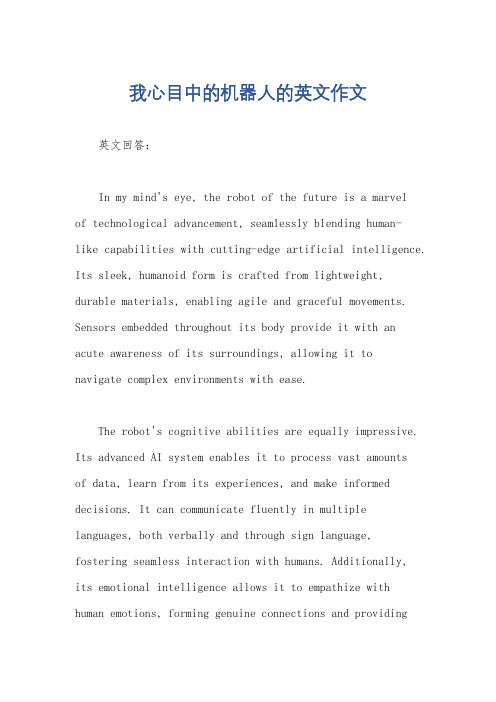
我心目中的机器人的英文作文英文回答:In my mind's eye, the robot of the future is a marvelof technological advancement, seamlessly blending human-like capabilities with cutting-edge artificial intelligence. Its sleek, humanoid form is crafted from lightweight, durable materials, enabling agile and graceful movements. Sensors embedded throughout its body provide it with an acute awareness of its surroundings, allowing it tonavigate complex environments with ease.The robot's cognitive abilities are equally impressive. Its advanced AI system enables it to process vast amountsof data, learn from its experiences, and make informed decisions. It can communicate fluently in multiple languages, both verbally and through sign language,fostering seamless interaction with humans. Additionally,its emotional intelligence allows it to empathize with human emotions, forming genuine connections and providingsupport when needed.Beyond its physical and cognitive attributes, the robot also possesses remarkable practical capabilities. It can perform a wide range of tasks, from mundane household chores to complex scientific experiments. Its precision engineering and tireless nature make it an invaluable asset in industrial settings, where it can work alongside humans to increase efficiency and productivity.However, the true value of the robot lies not only in its capabilities but also in its ethical design. It is programmed to prioritize the well-being of humans, adhering to strict ethical guidelines and always acting in accordance with human values. As a result, it poses no threat to humanity and serves as a trusted companion, enhancing our lives in countless ways.Overall, the robot of the future, as I envision it, is an embodiment of technological progress, human ingenuity, and ethical responsibility. It is a companion, a helper, and a force for good in the world, promising a brighterfuture for humanity.中文回答:在我心目中,未来的机器人将是科技进步的奇迹,完美融合了类人能力和尖端人工智能。
机器人的感知和认知能力

机器人的感知和认知能力随着科技的发展,机器人在人类社会中扮演着越来越重要的角色。
机器人的感知和认知能力是其核心功能,决定了其在各个领域的应用和表现。
本文将就机器人的感知和认知能力进行探讨,包括机器人的感知方式、认知能力的发展以及与人类的对比等方面。
一、机器人的感知方式机器人的感知方式主要通过传感器和摄像头等装置来获取外界信息。
传感器可以感知物体的温度、压力、湿度等参数,从而了解周围环境的变化。
而摄像头可以捕捉图像和视频,并通过图像识别技术来识别和理解图像中的内容,如人脸、物体等。
这些感知方式为机器人提供了对外界信息的基本认识。
二、机器人的认知能力发展机器人的认知能力是指其理解和分析外界信息的能力。
随着人工智能技术的不断进步,机器人的认知能力在逐渐提高。
机器学习和深度学习等技术使机器人能够通过大量的数据进行学习和训练,进而改善其感知和认知能力。
例如,机器人可以通过学习人类行为和语言来理解人类的意图,并做出相应的回应。
同时,机器人还可以通过与环境的交互和反馈来实时调整和完善自己的认知能力。
三、机器人与人类的对比尽管机器人的感知和认知能力不断提升,但相比于人类来说,还存在一定的差距。
首先,机器人的感知能力虽然可以通过传感器获取各种信息,但与人类的感知器官相比仍有限制。
例如,机器人无法像人类一样触觉敏感,无法感受到温度的变化和细微的压力。
其次,机器人的认知能力虽然可以通过学习和训练进行改进,但在某些情况下仍无法做出像人类一样的智能决策。
人类拥有复杂的思维和情感体验,而机器人仍然只能依靠程序和算法执行任务。
综上所述,机器人的感知和认知能力在科技发展中占据重要地位。
感知方式的不断创新和认知能力的提升使机器人能够更好地适应和应对复杂的环境和任务。
然而,与人类相比,机器人在感知器官和认知能力上仍存在差距。
未来随着科技的进步和人工智能的发展,相信机器人的感知和认知能力会继续得到提升,为人类社会带来更多的便利和效益。
机器人的感知与认知模型
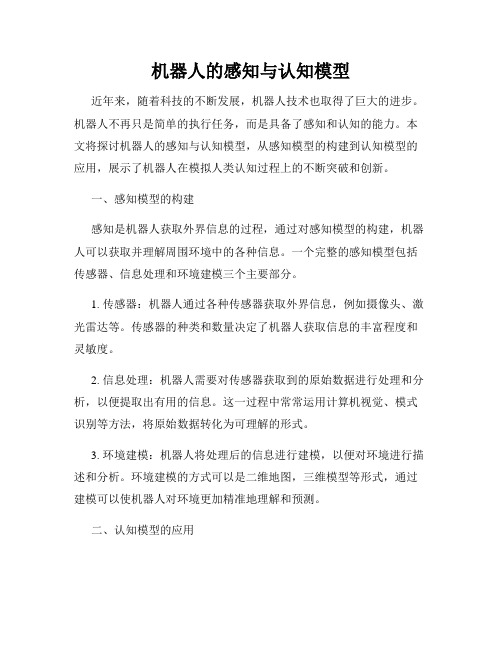
机器人的感知与认知模型近年来,随着科技的不断发展,机器人技术也取得了巨大的进步。
机器人不再只是简单的执行任务,而是具备了感知和认知的能力。
本文将探讨机器人的感知与认知模型,从感知模型的构建到认知模型的应用,展示了机器人在模拟人类认知过程上的不断突破和创新。
一、感知模型的构建感知是机器人获取外界信息的过程,通过对感知模型的构建,机器人可以获取并理解周围环境中的各种信息。
一个完整的感知模型包括传感器、信息处理和环境建模三个主要部分。
1. 传感器:机器人通过各种传感器获取外界信息,例如摄像头、激光雷达等。
传感器的种类和数量决定了机器人获取信息的丰富程度和灵敏度。
2. 信息处理:机器人需要对传感器获取到的原始数据进行处理和分析,以便提取出有用的信息。
这一过程中常常运用计算机视觉、模式识别等方法,将原始数据转化为可理解的形式。
3. 环境建模:机器人将处理后的信息进行建模,以便对环境进行描述和分析。
环境建模的方式可以是二维地图,三维模型等形式,通过建模可以使机器人对环境更加精准地理解和预测。
二、认知模型的应用认知是机器人对获取到的信息进行分析和理解的过程,通过认知模型的应用,机器人可以模拟出人类的认知能力,实现更加智能的决策和交互。
1. 知识表示与推理:机器人需要将获取到的信息进行知识表示,以便进行推理和决策。
常见的知识表示方式有规则、本体等,通过推理,机器人可以从已知事实中得出新的结论。
2. 学习与记忆:机器人可以通过机器学习的方法不断积累和优化自身的知识,从而提高认知能力。
同时,机器人还可以将学习到的知识进行存储和记忆,以便在后续的任务中应用。
3. 自然语言处理:机器人可以与人进行自然语言的交流和沟通。
通过自然语言处理技术,机器人可以理解和生成人类语言,实现更加智能化的人机交互。
三、机器人感知与认知模型的挑战与前景虽然机器人的感知与认知模型已经取得了重要的突破,但仍存在一些挑战和待解决的问题。
1. 处理多模态信息:现实世界中的信息往往是多模态的,机器人需要将不同传感器获取到的信息进行融合和处理。
机器人概念的总体理论

机器人概念的总体理论
机器人是一种能够自主感知、决策和执行任务的机械设备。
机器人的概念涵盖了多个方面的理论,包括以下几个主要方面:
1. 机器人感知与理解:机器人需要能够通过传感器获取周围环境的信息,并能够对这些信息进行处理和理解。
感知包括对视觉、听觉、触觉等感官信息的处理,理解则是指机器人能够从感知到的信息中获得对环境的理解和认知。
2. 机器人决策与规划:机器人需要具备决策能力,能够根据感知到的环境信息和任务要求做出合理的决策。
机器人还需要进行任务规划,确定实现目标的具体行动方案。
3. 机器人执行与控制:机器人需要能够根据决策和规划结果执行相应的动作,并保持稳定的运动控制。
这需要涉及到机器人的动力学、机械设计以及控制算法等方面的知识和技术。
4. 机器人学习与自适应:机器人需要能够通过学习和适应来提升自己的性能和适应不同环境。
机器人学习可以包括通过监督学习、强化学习等方法从大量数据中获取模式和规律,从而改进决策和执行策略。
5. 机器人与人的交互:机器人的设计也需要考虑如何与人类进行交互与合作。
这包括人机界面的设计、语音与图像识别,以及与人类共同完成任务的协作机制
等。
总体来说,机器人的概念理论非常庞大和复杂,并涵盖了多个学科领域的知识和技术。
机器人技术的发展将不断推动机器人概念理论的进一步探索和发展。
机器人的英语作文

Robots are fascinating creations that have captured the imagination of people around the world.They are not just mere machines but are designed to perform tasks that are either dangerous,difficult,or mundane for humans.Heres an essay on the topic of robots, exploring their various aspects and implications.IntroductionThe advent of robotics has revolutionized the way we live and work.From simple household appliances to complex industrial machinery,robots have become an integral part of modern society.They are designed to operate with a high degree of precision and efficiency,often exceeding human capabilities in certain tasks.Development and EvolutionThe concept of robots dates back to ancient times,with myths and stories of automatons serving humans.However,it was only in the20th century that the first programmable robots were developed.Over the years,advancements in technology have led to the creation of more sophisticated and versatile robots,capable of performing a wide range of tasks.Types of Robots1.Industrial Robots:These are designed for manufacturing and assembly line work, where they can perform repetitive tasks with high precision and speed.2.Service Robots:They are used in various sectors such as healthcare,hospitality,and agriculture,assisting with tasks that require interaction with humans or the environment.3.Exploratory Robots:These robots are built to explore environments that are hazardous or inaccessible to humans,such as deepsea exploration or space missions.4.Domestic Robots:They are designed for home use,performing tasks like cleaning, cooking,and even providing companionship.Impact on SocietyThe integration of robots into various sectors has had a profound impact on society.They have increased productivity,reduced human error,and in some cases,have made it possible to undertake tasks that were previously impossible.1.Economic Benefits:Robots can work continuously without fatigue,leading to increased efficiency and reduced labor costs.2.Safety:In industries where work environments are hazardous,robots can perform tasksthat would otherwise put human workers at risk.3.Quality of Life:Robots that assist with daily tasks can improve the quality of life for individuals with disabilities or the elderly.Ethical ConsiderationsDespite the numerous benefits,the rise of robotics also brings up ethical questions.1.Job Displacement:The automation of tasks by robots can lead to job losses in certain sectors,raising concerns about unemployment.2.Privacy:The use of surveillance robots raises issues about privacy and the potential for misuse of collected data.3.Autonomy:As robots become more autonomous,there are debates about the level of decisionmaking they should be allowed to have.Future ProspectsThe future of robotics is promising,with ongoing research and development aimed at creating robots that are more intelligent,adaptable,and capable of complex tasks. Advancements in artificial intelligence and machine learning are expected to further enhance the capabilities of robots.1.HumanRobot Interaction:Efforts are being made to improve the interaction between humans and robots,making them more intuitive and responsive.2.Cognitive Robots:The development of robots with cognitive abilities could lead to machines that can learn from their experiences and adapt to new situations.3.Ethical Frameworks:As robots become more integrated into society,the establishment of ethical guidelines and regulations will be crucial to ensure their responsible use.ConclusionRobots represent a significant leap forward in technology,offering numerous benefits and opportunities for advancement.However,it is essential to address the ethical and societal implications of their widespread use.As we continue to develop and integrate robots into our lives,it is crucial to strike a balance between technological progress and the wellbeing of society.。
- 1、下载文档前请自行甄别文档内容的完整性,平台不提供额外的编辑、内容补充、找答案等附加服务。
- 2、"仅部分预览"的文档,不可在线预览部分如存在完整性等问题,可反馈申请退款(可完整预览的文档不适用该条件!)。
- 3、如文档侵犯您的权益,请联系客服反馈,我们会尽快为您处理(人工客服工作时间:9:00-18:30)。
Bat Simulation Results
Lessoned learned
▪ The bat’s ear shape in combination with the frequency of its scream determines the direction in which it is listening
▪ Morphing Production Lines
QuickTime?a nd a H.263 de compressor are need ed to see this p icture .
D. Christensen, D. Brandt, University of Southern Denmark
Other Self-Reconfigurable Robots
M-TRAN, Distributed System Design Research Group, Intelligent Systems Institute, AIST
CONRO, Polymorphic Robotics Lab, Information Sciences Institute, USC
QuickTime?a nd a H.264 decompressor are neede d to see this picture.
QuickTime?a nd a H.264 decompressor are neede d to see this picture.
x4
The ATRON robot, D. Brandt and D. Christensen, University of Southern Denmark
QuickTime?a nd a YUV420 codec decompressor are need ed to see this picture.
USC’s ISI
Robust vs Fragile
▪ Difficult to detect if a module has failed ▪ Due to motion constraints it is difficult to eject the failed
Task-Optimized vs Stereotypical Tasks
▪ Task-optimized
▪ Body
▪ Task-optimized
Example: Body-Brain in Nature
▪ Why do bat ears have different shapes?
Example and graphics provided by Ralf Müller (CIRCE EU project, University of Southern Denmark)
▪ Prototyping mechanics and electronics is
▪ Time-consuming ▪ Expensive ▪ Requires skilled people
▪ A task-optimized body is rarely versatile ▪ Something else is needed..
▪ Modular robots may make it easier to find a balance between body and brain
Shape-Changing Modular Robots
▪ If robots can change shape autonomously
▪ Continually task-optimizing body ▪ Versatility ▪ Robustness (impact and self-repair) ▪ Cheap?
▪ Scalability ▪ Robustness
The State of Self-Reconfigurable Robots
▪ Vision
▪ Versatile ▪ Robust ▪ Cheap ▪ Task-Optimized
▪ Reality?
▪ Useless ▪ Fragile ▪ Expensive ▪ Stereotypical tasks
Versatile vs useless
▪ In practice motion constraints make it difficult to change shape
QuickTime?a nd a YUV420 codec decompressor are need ed to see this p icture .
Brain-Body Relationship in Robotics
▪ Brain (controller)
▪ Task-optimized
▪ Body (hardware)
▪ General-purpose*
*) to a large extend
Body-Brain in Nature
▪ Brain
QuickTime?a nd a YUV420 codec decompressor are need ed to see this p icture .
QuickTime?a nd a YUV420 codec decompressor are need ed to see this p icture .
Cognitive Robot
Kasper Stoy The Maersk McKinney Moller Institute
University of Southern Denmark
kaspers@mmmi.sdu.dk
Overview
▪ The body-brain relationship in cognition ▪ Modular robots as cognitive bodies ▪ Self-reconfigurable robots ▪ Deformable modular robots ▪ Hierarchical robots ▪ Conclusion
Self-Reconfigurable Robots
Self-Reconfigurable Robots
▪ Modular robots that can change shape by automatically rearranging the way modules are connected
Bat Ears
1. Bat ears cut off and digitized 2. Interaction between sound waves
and ear analyzed in simulation 3. Robot bat built to verify and use
results
module ▪ Due to weakness of modules it may not be possible to eject
the failed module at all
Cheap vs Expensive
▪ ATRON $2000 ▪ MTRAN $3500 ▪ ….
Real Tasks vs Stereotypical Tasks
▪ The physical structure of the bats ear does some “processing” for its brain
▪ The body of the bat aids cognition
Body-Brain in Robots
▪ We have a choice of where to implement intelligence
M-TRAN, AIST
Versatile vs useless
Start
D. Brandt, University of Southern Denmark
Goal
Versatile vs useless
▪ Too weak to interact with the world
▪ The ATRON and the M-TRAN robots can only lift in the order of a few modules
Brain
Body
QuickTime?a nd a YUV420 codec decompressor are need ed to see this p icture .
Asimov, Honda
QuickTime?a nd a YUV420 codec decompressor are need ed to see this p icture .
Versatile vs Useless
▪ A self-reconfigurable robot can change into any shape needed for the task
QuickTime?a nd a YUV420 codec decompressor are need ed to see this picture.
Software Challenge
▪ Control a swarm robot where
▪ Individual modules are physically coupled ▪ The connection topology is dynamic
▪ Preferable control should be distributed to allow
▪ Connection mechanisms ▪ Infra-red communication (with neighbours) ▪ Actuation (rotate one half sphere with respect to the other) ▪ Onboard batteries ▪ Processing power ▪ short-range sensors (infra-red) ▪ ...
